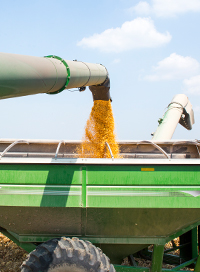 A new year is a great time to look back and take stock of the previous season. Reviewing the successes and difficulties of the past can help pave the way for a prosperous future.
A new year is a great time to look back and take stock of the previous season. Reviewing the successes and difficulties of the past can help pave the way for a prosperous future.
Three Corteva Agriscience market development specialists reflect on the last year and how farmers fared in their regions.
2020 Challenges
2020 was a challenging year. From sudden storms to a worldwide pandemic, farmers had many obstacles to overcome.
- The Derecho
In Iowa, Market Development Specialist Ron Geis says the most notable challenge was the Aug. 10 derecho, a system of wind and thunderstorms that swept across several Corn Belt states. Iowa was hit the hardest.
“The derecho was heartbreaking. Cornfields were flattened. Grain bin sites were flattened. For those who did have crops that could be harvested, the constant tension of being almost afraid to blink during harvest to watch for debris from the storm was exhausting,” Geis explains.
According to the National Oceanic and Atmospheric Administration, the storm system caused about $7.5 billion in damages.
For many of the states that avoided major damage by the derecho, weather was still a concern. - More Weather Challenges
“Pockets of Nebraska faced mid-, late-summer drought conditions, in addition to pockets of high winds and hail. We saw more southern rust in corn than in a normal year,” says Jason Gibson, market development specialist, based in Nebraska. - A Global Pandemic
And, of course, the coronavirus pandemic changed the way people worked in almost every industry across the country, including agriculture.
“This year’s challenges included weather, working amid COVID-19 protocols, as well as the always challenging agriculture economy,” remarks Nate Wyss, market development specialist, based in Indiana.
2020 Corn Yield
Depending on the state, yield suffered somewhat, or flourished, despite the challenges brought on by 2020.
On the bright side, Wyss says, it was actually a great year for corn in Indiana. “With the exception of a few dry pockets across the state, yield was stellar and early expectations are that Indiana will be up nearly 20% compared with 2019, setting a potential all-time record for corn yield,” he says.
In Iowa, the news was not so good. “Much of Iowa was in drought conditions, and corn that was planted on previous cornfields really showed lower yield,” Geis says. “Corn planted on soybean stubble yielded better, but the drought still took a lot of top-end yield off the crop. I credit our advanced genetics though — if we were planting the genetics from 30 years ago, this drought would have devastated yield.”
Gibson says Nebraska was a mixed bag. “We saw the most-ever 300-bushel-corn yield checks under irrigation in Nebraska. On dryland acres, yield ranged anywhere from good to poor, thanks to pockets of drought,” he says.
Looking at the bigger picture, according to the USDA, American farmers harvested an estimated 14.2 billion bushels of corn in 2020. That’s a 4% increase from 2019.
Weeds to Watch in 2021
The market development specialists advise taking note of the weed varieties that were trouble in 2020 and planning to control them in 2021.
Wyss says waterhemp and giant ragweed almost always cause difficulties in Indiana, so farmers there will want to plan for them this year.
“We continue to battle waterhemp across Iowa, with giant ragweed and marestail being the nemesis in spots," Geis says. "Woolly cupgrass is making a comeback — particularly around field edges. “Some customers are going back to applying extra residual around field borders to manage these problems.”
Gibson explains that Palmer amaranth and waterhemp were the most difficult weeds to control in Nebraska. He warns, “The weed seedbank has been building. Late-summer-to-early-fall rains may spur some heavy winter annual weed pressure. With the abnormally dry summer, we need to be prepared for the possibility of more heavy rains in 2021.”
Wyss, Geis and Gibson advise creating a program approach for flexible weed control this season to help overcome any challenges that might arise. This program approach should include a spring burndown and residual preemergence and postemergence applications.
By using last year’s lessons to prepare for spring now, you’ll be ready to tackle any obstacles. As Geis says, “Plan for success. Those who plan for success and those who plan for failure usually both get what they plan for. “
To help plan your program approach for 2021, check out these corn herbicides options to find the right solutions for your cornfields.